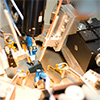| Sep 23, 2022 |
|
(Nanowerk News) One of the challenges encountered by research on novel electronic devices is to compare devices based on different materials in a consistent way. RWTH Professor Max Lemme and colleagues from USA, China, and Belgium have now proposed a set of clear guidelines for benchmarking key parameters and performance metrics of emergent field-effect transistors.
|
|
The guidelines have been published as a Perspective Article in Nature Electronics (“How to report and benchmark emerging field-effect transistors”).
|
 |
| Measurements on a graphene-based FET in a probe station at AMO. (Image: AMO)
|
|
Research on field-effect transistors (FET) has long explored the possibility of replacing silicon as channel material with emerging nanomaterials, such as carbon nanotubes, graphene, transition metal dichalcogenides, organic semiconductors, or ultrathin oxides. The field is thriving and keeps uncovering fundamental aspects of these materials. But when it comes to comparing the performance of different devices, there is often a lack of consistent reporting and benchmarking.
|
|
“Assessing consistently the potential of new materials for novel transistors is difficult, because the performance depends on many aspects and details of the device structure, and many parameters are interdependent.” explains Prof. Lemme.
|
|
Further complexity is added to the field by the interdisciplinarity of the research community, which includes electrical engineers, chemists, materials scientist and physicists. The multitude of approaches increases the challenge of reporting and benchmarking results consistently.
|
|
To address this situation, Lemme and colleagues have prepared a checklist of device parameters to be reported, as well as a list of recommended benchmarking plots to compare device parameters and performance metrics.
|
|
In addition, they present an explicit example of how to use the proposed procedure by applying it to the case of FETs based on monolayer molybdenum disulfide (MoS2), which is one of the emerging materials most studied in recent years for transistor application.
|
|
“To identify the real advantages and opportunities offered by novel materials in the search for improved transistors, we need to be able to benchmark and report different devices in a consistent way. We also need to make sure that all relevant data are reported every time.” adds Lemme. “We hope that our work will contribute to bring clarity in the community and guide the search for even better devices.”
|


